"10 Records Totally Owned by Mother Nature"
The usual candidates for this kind of list would be things like the highest mountain, or the longest river, or the biggest forest, or canyon, or other obvious stuff like that. But you probably already learned those things in school, and we here at TopTenz aren’t about the obvious and instead focus on bringing you other records. The ones people rarely talk about. So let’s do exactly that. Here are 10 other records owned by Mother Nature.
10: The Deepest Underwater Cave in the World – The Czech Republic
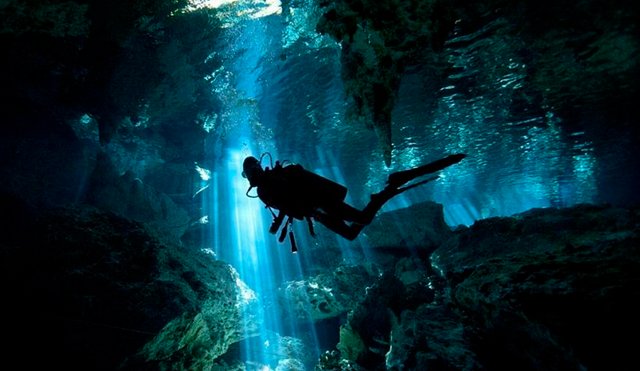
Located in the eastern part of the Czech Republic is the deepest discovered underwater cave in the world, the Hranicka Propast. The underwater cave is at least 1,325 feet deep, but nobody knows how much farther down it actually goes beyond that point. But even at this depth, the Hranice Abyss, as it is called in English, has beaten the previous record holder, the Pozzo del Merro in Italy by 39 feet. The Hranice Abyss’s existence has been known for some time now and the lead speleologist during this expedition, Krzysztof Starnawski, has been exploring it for the past two decades. The deepest dive he ever made was at 869 feet before he had to resurface and then stay for six hours in a decompression chamber.
The hot, mineral-rich, and carbon-saturated water that makes exposed skin itch suggests that the cave extends down a great distance. When its maximum depth of 1,325 feet was recorded, Starnawski made a dive to 656 feet, to a narrow point of the cave called the “squeeze passage” from which he launched a remotely operated underwater robot (ROV) the rest of the way. But when its cord ran out after another 670 feet, the robot still couldn’t see the cave’s bottom. Starnawski will undoubtedly try again, determined to get to the bottom, but he will obviously use a longer cord next time around.
9: The Oldest River in the World – Australia
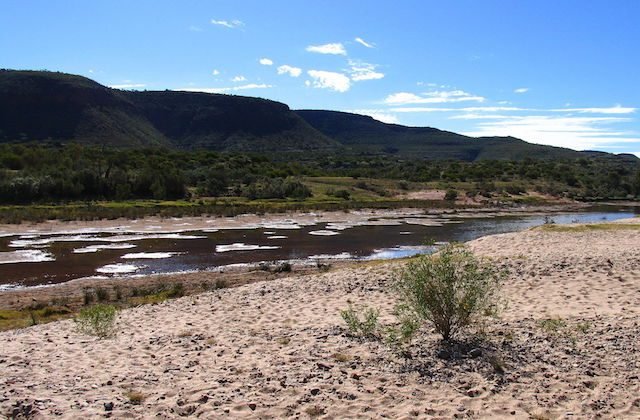
Finke River in Central Australia is not the longest river on the continent, but it’s definitely the oldest. It stretches for about 370 miles, from the MacDonnell Ranges in the Northern Territories to the western edge of the Simpson Desert to the south. But even though it’s one of the largest rivers in Australia, but not the longest, the Finke releases its waters onto the sand plains of South Australia and doesn’t actually reach the ocean. On rare occasions with periods of floods, the Finke can turn into a raging torrent. But in normal conditions, however, the Finke, like most others in Central Australia, looks like a broad, sandy river with nine permanent waterholes that are important sources of water for wildlife. But when heavy rains fall in the region, the Finke River can overflow and reach as far south as Macumba River and then into Lake Eyre, the lowest natural point in Australia at about 49 feet below sea level.
The age of the Finke River is believed to be somewhere around 300 to 400 million years. This is because the river goes through deeply incised meanders that can only form when a river flows through flat plains. But since the Finke flows through the James Range, which formed during a mountain building event in Australia known as the Alice Springs Orogeny, it means that the river was already there when the event happened more than 300 million years ago. Its second half, however, is much younger since the southern edge of the Northern Territories and the Simpson Desert were under the sea during that time. The Finke River has had more or less the same path for more than 100 million years and followed the exact same course as it does today for 15 to 20 million years.
8: The Oldest Mountain Range in the World – South Africa
Also known as the Barberton Greenstone Belt, the Makhonjwa Mountains in South Africa, close to the border with Swaziland, are a 75 by 37 mile range of small mountains and hills that can trace their origins back to 3.6 billion years ago. Given their incredible age, the mountains here aren’t all that tall, ranging in size from only 1,970 to about 5,900 feet. But scientists agree that by examining the remarkably well preserved rocks found here, they can deduce and understand the planet’s entire geologic history. Among these rocks, people have discovered some of the oldest signs of life on Earth and the area has since become known as the “Genesis of life.”
The Makhonjwa Mountains are also known for their gold deposits and an unusual type of volcanic rock that can only form at very high temperatures of over 3,000 degrees Fahrenheit (1,650 C.) – the highest temperatures for any volcanic rocks on the Earth’s surface. The gold found here is the oldest ever created on the planet. Back in the late 1800s alluvial gold sparked a mini gold rush in the area. Due to the steeply broken terrain, however, human habitation has always been marginal. Only after the arrival of the European colonists did the area began to see more permanent settlements, thanks in large part to the gold found there. But this gold rush was not to last, being quickly overshadowed not long after it started by the finds at the Witwatersrand Ridge near the city of Pretoria in 1886.
7: The Heaviest and Longest Living Organism – United States
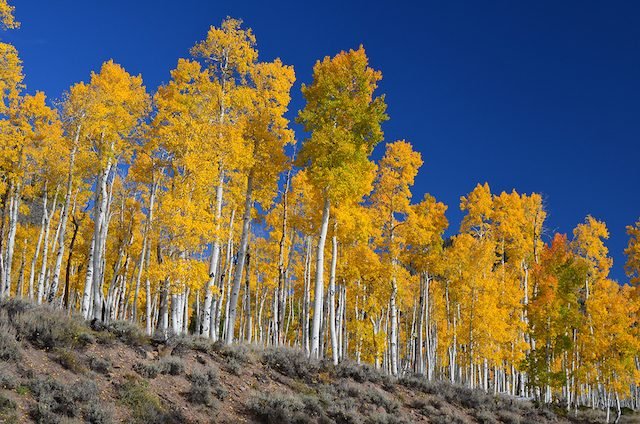
Back in 1976, some scientists from the University of Colorado estimated that there were some 47,000 individual quaking aspen trees in Utah’s Fishlake National Forest. The entire group of aspens, called a stand, covers an area of roughly 100 acres and has been identified in 2008 to actually be the exact same genetic tree that has cloned itself countless times over the years. The average lifespan of an aspen tree is around 100 to 150 years, and from their roots sprout other, genetically identical stems every several feet or so. The Pando stand, as it is called, is estimated to weigh in at around 6,615 metric tons, or about 13 million pounds. It also isn’t the only such aspen stand in the world, or even the United States, but it is without a doubt the largest.
And according to its size and the duration it takes each individual to sprout and grow, scientists have estimated the Pando stand to be anywhere in between 80,000 and one million years old. Determining the age of one such aspen stand is difficult at best, since it’s taking into account many other complex factors like climatic and biological shifts over many years. For instance, aspen trees also multiply by making use of seeds. But ever since the last ice age some 10,000 years ago, it’s believed that the Pando stand has never been able to flower because of the shifting climate. Aspens in New England, on the other hand, do so regularly. Today, there is another element that threatens the existence of this constantly-cloning organism. Large and medium-sized herbivores seek out these aspen sprouts, and over the past century many of the young stems have been eaten by deer, elk, sheep, and cattle. The average age of the current trees in the stand is about 130 years and fences have been put in place in order to keep animals out. Hopefully this will be enough.
6: The Largest Rocks in the World – Australia
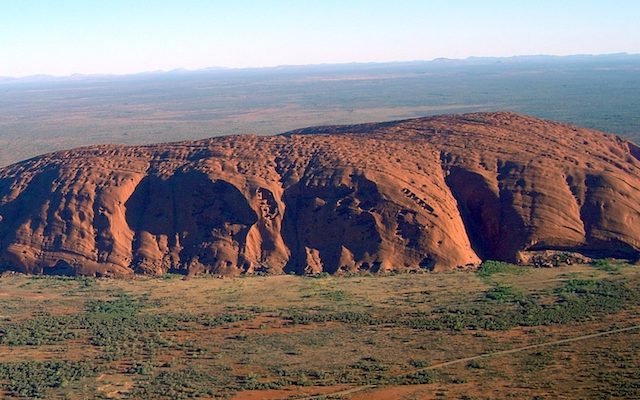
You probably never gave much thought to the “biggest rock on Earth” but there are some massive ones out there. One of them is located in Australia, about 208 miles from Alice Springs in the southern part of the Northern Territories. Its aboriginal name is Uluru, but it’s also known as Ayers Rock. Uluru is a sacred site to the Aboriginal people living in the area and it’s also a UNESCO World Heritage Site. The large sandstone monolith is one of Australia’s best known landmarks, towering some 1,142 feet above the surrounding land and 2,831 feet above sea level. It has a total circumference of 5.8 miles, extends into the ground to a depth of 1.5 miles, and came into existence some 600 million years ago when it lay at the bottom of the ocean. Uluru is one part of a trio of somewhat similar rock monoliths that were once all part of the same sandstone formation. The others are Mount Conner and Kata Tjuta.
Another notable rock formation is Mount Augustus, located in West Australia. It stands 2,820 feet above the surrounding landscape and 3,629 feet above sea level. Mt. Augustus is also 5 miles long, and covers a total area of about 18.5 square miles. Now, even though it’s twice the size of Uluru, Mt. Augustus is not a stone monolith per se, but rather a monocline. The differences between the two are relatively straightforward. While a monolith is, in this case, a single large piece of rock, a monocline is an exposed slab of rock belonging to a stone layer beneath. The stone layer formed some 1.6 billion years ago when it was still at the bottom of the ocean and then buckled into its present form some 900 million years ago. The extra sediments once covering it have since eroded away, exposing the bare rock beneath.
5: The Tiniest Mammal in the World – Thailand
How small can a mammal get? We’ve all seen tiny lizards, frogs, insects, and even birds, but mammals are usually bigger, right? Well, not necessarily. Native to the jungles of Thailand, Kitti’s hog-nosed bat is roughly the size of a bee – thus its occasional name of Bumblebee bat. It was first identified in 1974 by a Thai zoologist, Kitti Thonglongya, who gave it the name of hog-nosed because of its pink, pig-like snout. The tiny bat inhabits areas of western Thailand and southeastern Myanmar and usually lives in colonies of 10 to 100 individuals that dwell in limestone caves, located near rivers. Their group numbers can sometimes reach as many as 500. It weighs only two grams and measures around 1.1 inches, and its wingspan is about 6.7 inches. They feast mostly on insects and have dark-colored wings with long tips that allow them to glide and hover in the air.
Not much is known about these tiny creatures, but it’s believed that they give birth to one single baby each year at the end of April. They usually dwell deep inside caves and most often stay in groups of 10 or 15 individuals in different parts of the cave. They have a short activity period, leaving their caves for about half an hour in the evening and 20 minutes at dawn. Their foraging can always be cut short by heavy rains or cold weather. Unfortunately, however, the Bumblebee bat is currently classified as vulnerable because of deforestation, loss of habitat, and increased tourist activity in the area.
4: World’s Largest Ice Cave – Austria
Located some 25 miles south of Salzburg, Austria lies the largest ice cave in the world. The Eisriesenwelt, or World of the Ice Giants, is a natural limestone cave in Werfen, Austria that extends for about 26 miles into the mountain. It was created some 100 million years ago by the Salzach River, which found its way through the limestone cracks in the mountain and then slowly eroded it to create this World of the Ice Giants. But even though the cave extends for 26 miles, only the entrance and the subsequent 0.6 miles are covered in ice. It was first discovered back in 1879 and is considered to be a dynamic cave. This means that there are other openings in the upper levels that allow for a strong draft to form and the air to circulate freely through the cave.
Every spring melting water seeps in through the cracks and when it reaches the cave’s lower levels, where the main entrance is, it freezes. And since the entrance of the cave is open all year, in winter the colder air from outside blows into the cave and freezes the inside. In summer, the air circulation is reversed and cold air from inside the cave keeps the ice from melting. Every year, some 200,000 tourists visit the World of the Ice Giants marveling at the natural ice sculptures, some of which tower at over 75 feet.
3: The Oldest Forest in Existence – Australia
Some 335 million years ago, all the planet’s landmasses came together to form the supercontinent of Pangaea. This wasn’t the first time this happened and it will most certainly not be the last. Nevertheless, about 175 million years ago, Pangaea eventually broke apart, with one of its landmasses going north and eventually turning into what we now know as North America and Eurasia. The other half, known as Gondwana, shifted south. During this time, an immense and ancient tropical forest began to take root here; a forest that would end up covering pretty much the entire Southern Hemisphere. Over the many millennia since, Gondwana, too, broke apart into South America, Africa, India, Antarctica, and Australia, which then slowly took up their current locations on the globe.
But in doing so, almost all of them lost their share of the tropical forest. Only Australia kept relatively the same latitude as the ancient continent of Gondwana, and the forest never really disappeared, though it did change. Don’t let this description lead you to believe that the forest is the same as it was 170 million years ago, because it isn’t. Over time, old species of plants and animals gave way to newer ones, but the Gondwana Rainforest, as it‘s known today, has been in continuous existence since before the dinosaurs. At present, however, the Gondwana Rainforest makes up just 0.3 percent of Australia and it is only found on its eastern coast.
This small distribution is due to the continent’s drift towards the northern hemisphere, making it hotter and increasingly unsuited for a subtropical rainforest. Over time, lush forests gave way to grasslands and then to the scorching desert we see there today. But even so, the Gondwana Rainforest, in its current form, is still the largest subtropical forest in the world and holds some of the oldest species of ferns and conifers on the planet. It is also home to some of the earliest flowering species of plants that first appeared in this once immense forest. Today, the Gondwana Rainforest is home to about half of all plant life found on the continent, as well as about a third of all birds and land animals – some of which are endemic and found nowhere else on Earth.
2: The Largest Single Living Organism of Earth – United States
The Blue Mountains in eastern Oregon are home to the largest living organism on the planet. But even though it is huge, you won’t be able to see it if you don’t know what to look for. The first sign that the organism is there in the first place is that some trees seem to die in its presence. The organism we’re talking about here is a fungus. A giant Armillaria ostoyae, to be more exact. Since it lives mostly underground, people only became aware of its presence after a team of forestry scientists began mapping eastern Oregon’s pathogenic fungus distribution. The A. ostoyae causes the Armillaria root disease that infects conifers in many parts of North America. The fungus usually grows along tree roots and has the capability to extend between different trees while underground, and thus have a wider distribution.
By taking samples from different sites in the Blue Mountains, these forestry scientists were able to deduce that all of them were, in fact, the same organism covering an incredible area of about 2,384 acres. There are other fungi in the genus Armillaria, as well as other A. ostoyae that have large distributions and somewhat similar feeding habits, but none come close to this one in eastern Oregon. Thanks to a series of good genes, favorable topography, and a stable environment to thrive in, this particular fungus has grown to an amazing size over the past 2,400 to 8,650 years. This also places it among the oldest creatures on the planet.
1: Fastest Moving Continent – Australia… again
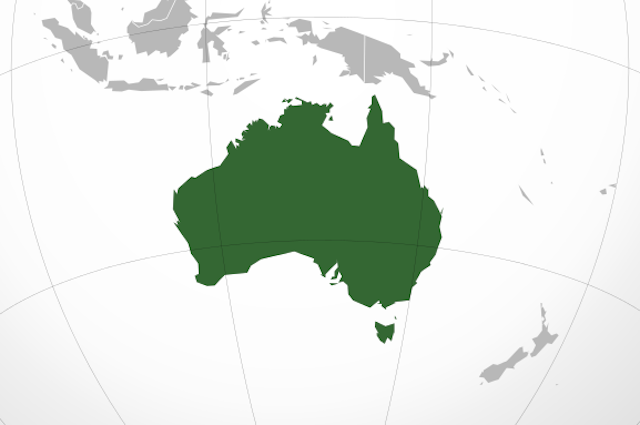
Our knowledge of plate tectonics isn’t that old, and this can’t really come as a surprise to anyone. After all, we don’t live nearly long enough to witness any meaningful changes in the greater scheme of things on the planet. This doesn’t only apply to the positions of the continents relative to each other. Nevertheless, only in 1963 did scientists come to realize that the continents are in constant movement over a plastic-like layer of the upper mantle of the Earth. And depending on the consistency of that upper mantle layer, the fact that the Earth is not a perfect sphere, the mineral composition of each individual continent, as well as a series of other factors, continents move at different speeds and in different directions. But even though these changes don’t seem like much when it comes to our everyday lives, Australia’s “breakneck speed” of 2.7 inches per year has now created some problems when it comes to the accuracy of GPS.
For GPS to work properly, it needs two satellites in orbit and a transmitter on the ground (your phone, for instance) in order to create a triangulation, as well as an accurate map for your GPS to display your exact location. But since the last adjustment was brought to GPS coordinates in 1994, Australia has moved some 4.9 feet. This means that, even if your GPS works perfectly, it will still show you to be some 4.9 feet to the south of your current location. That’s if you live in Australia, of course. So, if you’re a precision freak and constantly get annoyed by your GPS always locating you in your neighbor’s house, you should blame your fast-moving continent. Australia is, in fact, drifting north and has a slight clockwise rotation. But don’t worry, because people are looking into the issue and it will soon be fixed.
The previous record holder was the Indian Subcontinent. At some point during its geological past, it was moving towards Asia at a speed of about 6 inches per year, or even faster. When they inevitably collided, the Himalayas came into being. They are still growing, in fact, but since then, India is only pushing into Asia proper at about 2 inches per year.